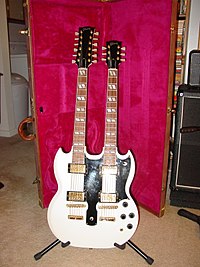12-string acoustic guitar
 |
|
| Manufacturer | Gibson |
|---|---|
| Period | 1963–1968, 1974–1998, 1998–present |
| Body type | Solid |
| Neck joint | Set (Twin) |
| Body | Mahogany |
| Neck | Mahogany (vintage) or Maple (today) |
| Fretboard | Rosewood |
| Bridge | Tune-O-Matic |
| Pickup(s) | Two 490R Alnico magnet Humbuckers (12 and 6 string) |
| Alpine White with Gold Hardware, Heritage Cherry with Chrome Hardware | |
The twelve-string guitar is a steel-string guitar with twelve strings in six courses, which produces a richer, more ringing tone than a standard six-string guitar. Typically, the strings of the lower four courses are tuned in octaves, with those of the upper two courses tuned in unisons. The strings are generally arranged such that the first string of each pair to be struck on a downward strum is the higher octave string; however, Rickenbacker usually reverses this arrangement on its electric 12 string guitars. The gap between the strings within each dual-string course is narrow, and the strings of each course are fretted and plucked as a single unit. The neck is wider, to accommodate the extra strings, and is similar to the width of a classical guitar neck. The sound, particularly on acoustical instruments, is fuller and more harmonically resonant than six-string instruments.
Structurally, twelve-string guitars, especially those built before 1970 (see below), differ from six-string guitars in the following ways:
Twelve-string guitars are made in both acoustic and electric forms. However, it is the acoustic type that is most common. Some progressive rock (Alex Lifeson, Roger Hodgson), hard rock (Jimmy Page), progressive metal (John Petrucci), and heavy metal (Dave Mustaine) musicians use double-necked guitars, which have both six-string and twelve-string components, allowing the guitarist easy transition between different sounds.
The double ranks of strings of the 12-string guitar produce a shimmering effect, due to the fact that even the strings tuned to unisons can never vibrate with precise simultaneity—that is they vibrate out of phase. The result to the ear is a sound that seems to "shimmer", which some describe as resembling strings that are slightly detuned. The interference between the out of phase vibrations produces a phenomenon known as a beat that results in a periodic rise and fall of intensity that is, in music, often considered pleasing to the ear. Pete Seeger described the distinctive sound of the 12-string guitar as "the clanging of bells". The effect is more apparent when listening to notes that sustain for longer periods of time.
...
Wikipedia
